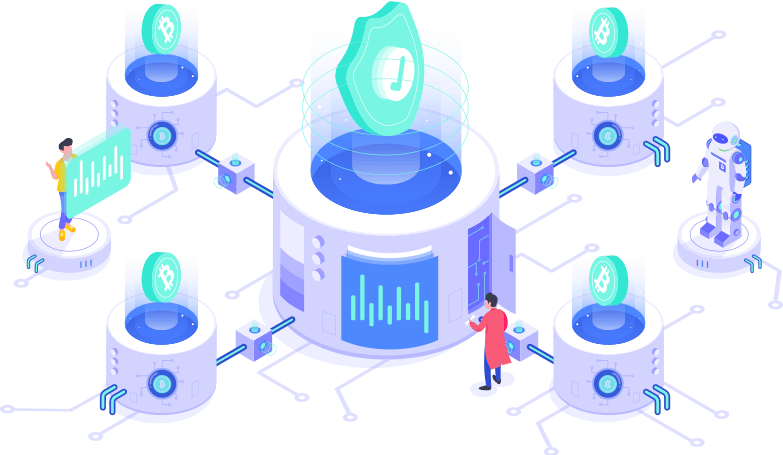Our
Business

VALIDATOR NODES

CRYPTOCURRENCY MINING
Unlike validation chains, “proof of work” chains have miners that add new blocks of transactions to the blockchain on they have algorithmically solved the encryption.
Blockchain
Infrastructure
MASTER NODES
What Is A MasterNode?
Masternodes are one half of the Proof of Work blockchains such as, Bitcoin, Litecoin, FLUX, etcetera.
Unlike regular nodes, master nodes do not add new blocks of transactions to the blockchain. Instead, they verify new blocks and perform special roles in governing the blockchain.
One of the major roles of a masternode is to store every block, piece of data, & blockchain transaction all the way back to the very first block & transaction on the specific blockchain, on the masternode operator’s own private servers.
Why Do MasterNodes Matter?
There are hundreds, if not thousands, of masternodes supporting any given blockchain network. This is how the blockchains stay operational 24 hours a day, and rarely have network outages, while also keeping the blockchain decentralized and secure.
Masternodes are what make the blockchain trackable. Since every masternode houses all data from that blockchain from the blockchain’s inception, if that node were to ever disconnect from the network there are always other nodes running & storing the blockchain data.
Masternodes require collateral, and certain server memory requirements to host. The masternode operator collateralizes their blockchain coin asset, runs the masternode on their own servers that meet the specific hardware requirements, validate blocks and store data, and then are rewarded for hosting the blockchain. Most masternodes coin collateral requirement are the same for every node.
What Is The Reward?
Predominantly, there is a 50/50 split between miners that algorithmically solve the blocks, and the masternodes that validate & store them.
Masternodes are rewarded in the blockchain native coin as long as they are connected to & hosting the network. They are essentially paid a part of the “fees” that blockchain transactions bring in (usually 50%) from users that are sending coins/tokens on the network the operator is helping host.
VALIDATOR NODES
What Is A Validator Node?
Validator nodes are the entirety of the “Proof of Stake” blockchains such as Ethereum, Avalanche, Binance Smart Chain, etcetera. This means there is NO MINING on Validation Chains like Ethereum.
Validators do not add new blocks of transactions to the blockchain. Instead, they verify new blocks, store the blockchain data, vote on proposals on the network, and validate transactions like a traditional miner would.
One of the major roles of a validator node is to store every block, piece of data, & blockchain transaction all the way back to the very first block & transaction on the specific blockchain, on the validator operator’s own private servers.

Why Do Validator Nodes Matter?
There are dozens (and sometimes hundreds, if not thousands) of validator nodes supporting any given Proof of Stake network. This is how the blockchains stay operational 24 hours a day, and rarely have network outages.
These Validator nodes are what make the blockchain trackable and decentralized, and actually authenticate all of its transactions.
Since every validator node houses all data from that blockchain from the blockchain’s inception, if that validator were to ever disconnect from the network there are always other nodes running & storing the blockchain data.
There are hundreds, if not thousands, of masternodes supporting any given blockchain network. This is how the blockchains stay operational 24 hours a day, and rarely have network outages.
Validator nodes are what make the blockchain trackable, secure, and decentralized. Since every validator node houses all data from that blockchain from the blockchain’s inception, if that node were to ever disconnect from the network there are always other nodes running & storing the blockchain data.
Validator nodes have a minimum coin collateral requirement (for example: AVAX is 2,000 coins), and certain server memory requirements to host. The validator node operator collateralizes their blockchain coin asset, runs the validation program on their own servers that meet the specific hardware requirements, validate blocks that decrypt the transactions, store the data, and then are rewarded for hosting & validating the blockchain.
What Is The Reward?
Predominantly, validators generate anywhere from 5% to 20% APR (without taking into account price appreciation) for algorithmically solving the transaction blocks and storing the data.
Some validators have more fluid APRs that are dependent upon the size of their stake compared to the other validators, their reputation of validation (whether or not they missed any attestations), their validator “network up-time”, their staked period (how long are their coins staked & locked for), among other factors.
Validator nodes are rewarded in the blockchain native coin as long as they are connected to & hosting the network during their specific attestation periods for every epoch that is delegated to them. They are essentially paid a part of the “fees” that blockchain transactions bring in from users that are sending coins/tokens on the network the operator is helping host. The more transactions on the chain, the higher the reward for validation.
CRYPTOCURRENCY MINING
What Is Cryptocurrency Mining?
Cryptocurrency mining (or “Miners”) are the second half of the Proof of Work blockchains such as, Bitcoin, Litecoin, FLUX, etcetera.
Unlike validation chains, “proof of work” chains have miners that add new blocks of transactions to the blockchain on they have algorithmically solved the encryption. Once they are mined and verified, those blocks are sent to the master nodes to be stored on the master node servers.
The key role of the miners is to validate and decrypt every block, piece of data, & blockchain transaction in order to validate it and send it to be stored on the blockchain. This is a very complex algorithmic process that requires tremendous computing power that most stand-alone servers do not possess.
Why Do Miners Matter?
There are thousands, if not millions of miners supporting any given blockchain network. This is how the blockchains stay operational 24 hours a day, and rarely have network outages, while also keeping the blockchain decentralized and secure.
Miners are what make the blockchain trackable. They literally decrypt all transaction data so that it can be verified and sent to masternodes to be stored and tracked.
Miners do not require collateral but require a massive amount of computing power to run the mining operations and program. Specific mining “rigs” are purchased with the computing power already built into them and require massive amounts of power as well as a strong internet connection. This is capital and labor intense, but without miners “Proof of Work” blockchains could not run.
What Is The Reward?
Predominantly, there is a 50/50 split between miners that algorithmically solve the blocks, and the masternodes that validate & store them.
Masternodes are rewarded in the blockchain native coin as long as they are connected to & hosting the network. They are essentially paid a part of the “fees” that blockchain transactions bring in (usually 50%) from users that are sending coins/tokens on the network the operator is helping host.

